Will a secondhand Sprocker make a good peg dog?
Gundog training: Someone’s offered me a four-year-old, male, Sprocker – free! It’s been used as a beating dog, and I’m…
Win CENS ProFlex DX5 earplugs worth £1,149 – enter here
My new cocker spaniel puppy is eventually going to replace my 10-year-old springer spaniel. I have spoken to several people and have received different views on training a cocker spaniels. I would appreciate some advice.
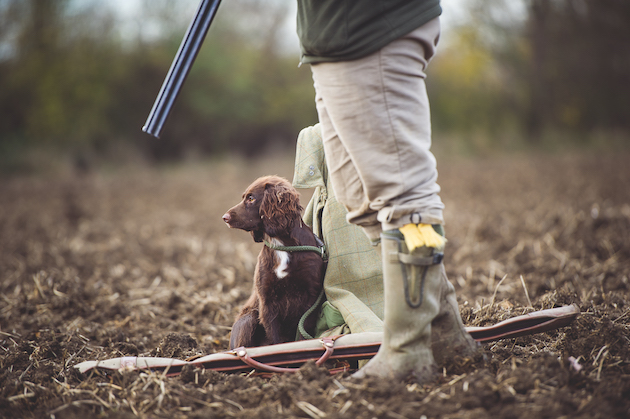 Chocolate cocker spaniel
Chocolate cocker spaniel
“Come here you horrible thing!” The shout echoed across the fields as a brown blur tore through the dewy grass with a lead and wooden peg rattling behind it.
I would love to report this was another Gun’s experience but alas, it was my disobedient dog. It was a frosty December morning some years ago and, as I watched my then two-year-old cocker, Bubble, disappear into the mist, I couldn’t help wondering whether I had the wrong dog for the job. Perhaps I should just join the beating line.
My father has been wary of having spaniels as peg dogs ever since he had a springer called Bundle. Bundle’s first love was chasing deer and more than once he’s told me about people he once counted as friends who no longer send him Christmas cards as a result of Bundle tearing off through their drives and ruining the day.
Bubble, though not related to Bundle in any way, and certainly not nearly as wild, has a few similar traits. Accordingly, my uncouth father refers to my little chocolate-coloured dog as“the flying turd”. “Get a Lab,” he said one evening after I vented my frustration about the dog, “much better on the peg.”
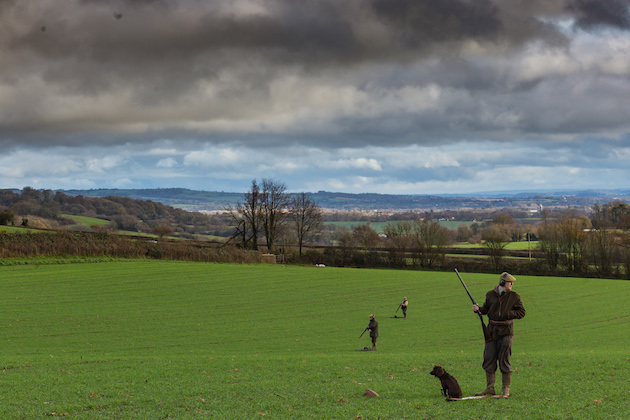
Ed and Bubble – who is behaving quite angelically for a change – out shooting in December 21018
For the next few months, I thought hard about it. I have always enjoyed my shooting and there have been days when it would have been much better if I hadn’t been constantly concerned that Bubble was about to roar off. Then one afternoon I was at my grandparents’ house and came across an old copy of Shooting Times with a piece by Peter Moxon. “The gundog question is one of temperament,” wrote the acknowledged expert, “not only of the dog but of the owner.”
This gave me a little hope in the sense that, if I could alter my temperament slightly, Bubble would work better for me. It was worth a go.
Moxon’s words came back to me one morning when Bubble was halfway through a particularly mournful song on one drive and I felt frustration bubbling up after missing two partridges on the trot. I might have shouted and screamed but instead I quietly took her aside and distracted her with a half-eaten ham sandwich I had in my coat. It worked to an extent.
Admittedly, if Bubble had been less loveable I might have felt differently. But she is loved by so many — on and off the field — that I felt obliged to stick with her.
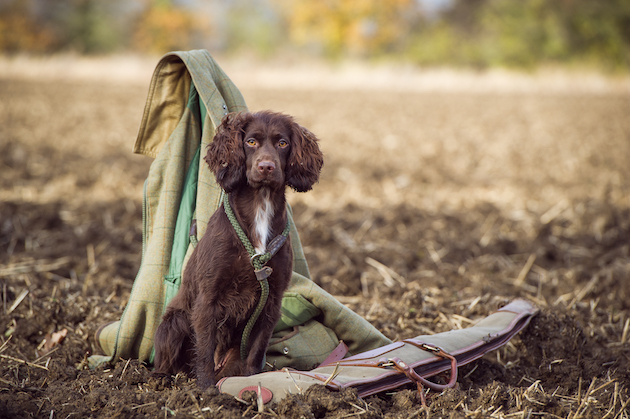
Cocker spaniels were originally bred for hunting woodcock
Reading more about cockers, in attempting to understand my own, I learned that their popularity in the British sporting world has been growing since the 1920s. And the cocker has won best in show at Crufts more than any other breed. Initially bred for hunting woodcock — hence the name — and driving game towards the Guns, cockers are now used in a wide variety of jobs in shooting.
They have developed a tendency to adapt to more facets of our sport than originally intended. So you could say we have developed and nurtured the breed into becoming something much more suited to the peg nowadays than they were in decades gone by.
At this year’s Game Fair I had a drink with Ellena Swift, our regular gundog trainer in Shooting Times, and asked her thoughts on the cocker-on-the-peg conundrum. She replied that she is no stranger to training a cocker spaniel as a peg dog. “They are very versatile little dogs that can turn a paw to almost anything. However, they are naturally ‘busy’ and normal peg dog attributes are not something that come easily to them. So it is all down to the handler to instil the basics first.”
I then spoke to Jeremy Hunt of Fenway Labradors, whose feelings were a little more mixed. “Steadiness is usually the big issue. The obvious reason is that cockers are primarily hunting and flushing dogs,” he said. “I always feel rather sorry for them because their mind is supposed to be focused on being totally composed, while their heart is where the action is in the beating line.”
Being a peg dog is a job that requires three key attributes: retrieving, sitting on a peg calmly and — something that Bubble fails on constantly — being quiet. Every once in a while you hear a subtle whining down the line that increases in volume to the kind of soulful singing that would rival some of the former X Factor contestants.
This noise is not only an annoyance to most Guns but it also makes the owner look a complete fool at training said dog. If you are thinking about whether the whining is due to the dog’s unhappiness, Andrew Wylie — another Shooting Times contributor of old — said: “The cocker’s spirit is so resilient that it is almost impossible for you to dampen it on a shooting day. Its principle is to please the alpha.”
The whining is a signal that the dog is so eager to get going that all its energy comes out in sound.
But according to Ellena, this noisiness can be cured quite effectively through early handling. She says the key is focus on the basics first. “Sit and heel will almost certainly be the biggest challenge the handler faces. This entails steadiness, quiet and a willingness to remain at the handler’s side unless instructed otherwise.”
The cocker is an excitable dog and its happy disposition and continuously wagging tail have earned it the nickname ‘the merry cocker’. Handling this ‘busy-natured’ dog and calming everything down is one way of ensuring that it can thrive and stop the sound problems.
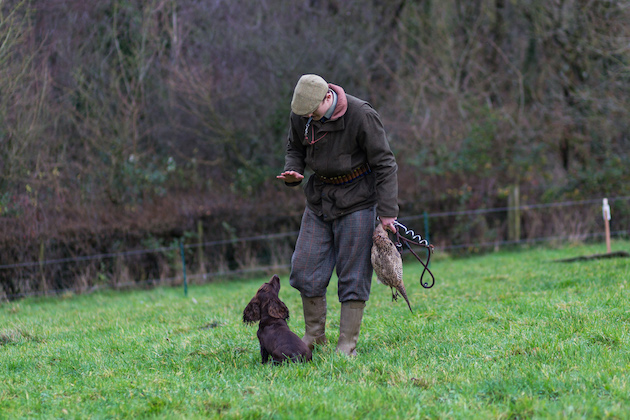
Ed wouldn’t swap Bubble for any other dog in the world
Retrieval of shot birds is one of the peg dog’s main responsibilities. Thirty or 40 yards out is the usual distance for a bird to hit the ground and cockers, with their natural hunting ability, are very capable of finding those birds. However, a large January cock pheasant may cause a problem due to the size of the cocker.
Bubble is quite a small dog but she amazed me last season by retrieving a large running cock pheasant. I have trained her with larger dummies that are a challenge to pick-up to prepare her for the weight of the bird, and that gives her confidence to do it in the field when tested. However, another issue when training cockers to retrieve birds from the peg is that it is against their nature.
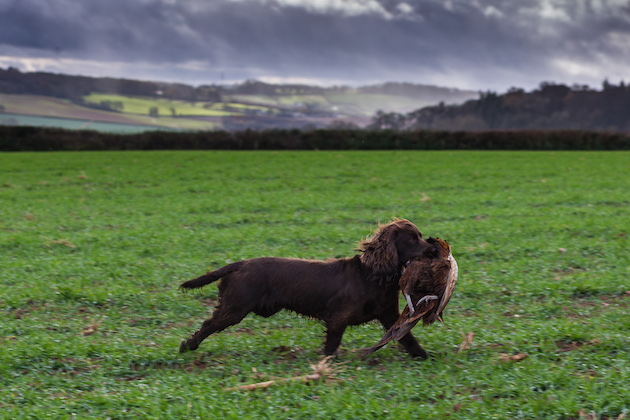
Bubble proudly retrieves a January cock pheasant that is extremely heavy to carry
“[The cocker] is bred to hunt, quarter and look in thick cover, so while they will hunt for lost birds well, normally a Gun will be sending their dog from the peg rather than walking out to hunt it,” explained Ellena. “Controlled distance handling can be a challenge for them as they would rather hunt every inch of ground to the fall of a bird instead of running in a straight line.”
This may not be ideal but, with plain-sight training and using your arm and body to position the direction the dog should be taking, it should make a beeline for the dummy.
A proven peg dog is one that can sit by the Gun without a lead tethering it. It is the level most owners, including me, strive for. I have seen plenty of what I thought were level-headed dogs tied to the peg more out of fear and uncertainty than anything else.
Labradors are the most common dog in the line, closely followed by well-trained springers and retrievers. Cockers are naturally excitable so to sit in the same spot for the drive — say 20 minutes — is a big ask. But it can be done, providing the owner stays with the right training and has plenty of perseverance.
“Some are ready at 12 months, others aren’t ready until at least three years,” said Ellena. “People take them out on a lead thinking that introducing them to sights and sounds will do them good. All it does is create a very frustrated dog who hasn’t learned self control.”
The key to overcoming this is to do it little by little and introduce them slowly. If they can’t handle it go back a step and start again.
Gundog training: Someone’s offered me a four-year-old, male, Sprocker – free! It’s been used as a beating dog, and I’m…
Q: I am getting my first Labrador puppy soon, which besides being a family pet, will be my shooting dog…
Bill Meldrum may have lived down south for more than 50 years but he is a Scottish gamekeeper through and…
Ellena finished our conversation by saying: “If the foundations of training are solid and the handler takes their time, there is no reason they can’t make a cracking little peg dog.”
Despite his earlier misgivings, Jeremy agreed: “Ultimately, It’s all about the dog. The right cocker in the right hands can make a peg dog.”
However, I would caution every budding cocker owner that it is not
an easy road and it takes a lot of time and effort. For a beginner, the rewards are sweet if you accomplish it. But if you are not willing to put in the extra hours, don’t be surprised
to see your peg and lead vanish after
a fleeing pheasant on the first drive.
Bubble may not be the dog that gets left on the peg for two hours without moving, but I would not trade her for another dog. To me, the cocker has every right to sit beside the peg.
Get the latest news delivered direct to your door
Discover the ultimate companion for field sports enthusiasts with Shooting Times & Country Magazine, the UK’s leading weekly publication that has been at the forefront of shooting culture since 1882. Subscribers gain access to expert tips, comprehensive gear reviews, seasonal advice and a vibrant community of like-minded shooters.
Save on shop price when you subscribe with weekly issues featuring in-depth articles on gundog training, exclusive member offers and access to the digital back issue library. A Shooting Times & Country subscription is more than a magazine, don’t just read about the countryside; immerse yourself in its most authoritative and engaging publication.

